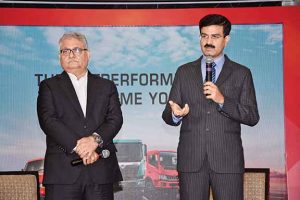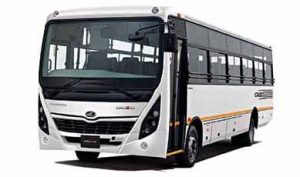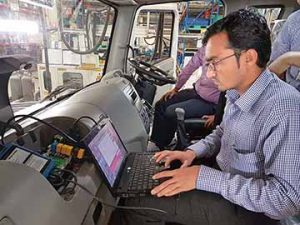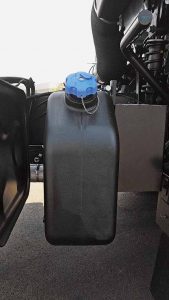Story by: Bhushan Mhapralkar
Fighting to overcome the market perception that its HGVs were dandy and powerful, but not as fuel-efficient, Mahindra Truck and Bus Division (MTBD) has announced that its Blazo HGV range is the market leader in terms of mileage within the trucking industry. It has also announced that its Furio ICV (in the 12- and 14-tonne segment) has emerged as the number four-player in a short span of seven months. Using its 7.2-litre engine that powers the Blazo HGV range to a distinct advantage in its journey to BSVI, MTBD has claimed to have emerged as the number-three player in the haulage segment (multi-axle vehicle segment and tractor-trailer segment combined). The dandy build of its HGVs providing it with an advantage of meeting the new axle norms with ease, the CV maker is eyeing the number-three position in tippers. Keen to offer a simplified BSVI experience to its customers in the wake of the challenges they are already facing, the company, according to Rajan Wadhera, President – Auto Sector, Mahindra & Mahindra, has had the distinct cost advantage from packing technology in its CVs before the regulations could dictate.
Of the opinion that the pre-buying of CVs will not be to the scale earlier envisaged, MTBD is confident of consolidating its position in the BSVI environment. Equipping its HGVs with a 10-bar pressure braking system and leveraging the dandy build even before the new axle norms necessitated it, the CV manufacturer is conducting rigorous testing and validation of its CVs for BSVI in close coordination with the passenger vehicles, pick-up trucks and SCVs teams in the automotive division. Introducing the 49-tonne Blazo X 16-wheel rigid truck with an advantage of superior fuel efficiency and higher payload, the company, said CEO Vinod Sahay, is sticking to its promise of mileage guarantee.
Launching the 11 m Cruzio bus, which marks an entry into the long platform overhang bus segment, MTBD has consistently gained market share from 2.6 per cent to 4.8 per cent. It has also managed to gain some market share in an environment where the fall in sales of M&HCVs has been the most drastic, followed by that of the ICVs and LCVs. Claiming to sell its CVs at a premium(the Blazo commands a premium of at least Rs.75000) in a heavy discounting scenario, MTBD according to Sahay, is the only CV maker to offer fuel efficiency guarantee (return the truck if unfulfilled). Informing that none of the 26000 Blazo HGVs it has sold in the last three years has come back, Sahay said, that their trucks are being benchmarked in the industry for fuel-efficiency.
Keen to provide technologically superior products with the Indian value system in view, the CV maker has been selling new GVW trucks for the last four months. These trucks were tested and validated as per new GVW. Looking at ways to enhance the safety, efficiency, performance, and comfort of its CVs, MTBD will launch all the variants of the Furio after BSVI emission norms come into force. Expressing that the Blazo has changed the perception of his company completely, Sahay mentioned they progressively gained a price advantage. “The HGVs we sold before the introduction of the Blazo were priced lower than the industry level. The Blazo has come to command a premium of at least Rs.75000,” he added. Stating that they would have gained more market share if they would have agreed to match the discount levels of industry leaders, Sahay said, “So far, three models of the Furio in BSIV configuration have been launched.”
Selling the Furio at a premium of one to one-and-a half-lakh rupees over what the industry charges, MTBD, preparing to introduce a seven-tonne variant of the Furio by April of 2020, is waiting for the availability of BSVI fuel. It is gearing up to pre-produce a batch of BSVI CVs in the next few months and seed them with some select customers to test and validate. Subjecting its CVs to homologation, the CV maker plans to bill BSVI vehicles to its dealers by February and March 2020. Carrying forward the existing (7.2-litre and 3.5-litre) common-rail engines to BSVI along with key aggregates like engines, transmissions, axles, brakes, and the cabins, Sahay explained that the hardware commonality between BSIV and BSVI is more than 80 per cent. The most changes, he added, are at the software and after-treatment level. To get the truck and bus customers to experience the least burden in an already challenging environment, the CV major is working to get the fluid efficiency right. It is arming all its CVs with an SCR system, including the Jayo and Optimo.
Deploying DOC (Diesel Oxidation Catalyst), DPF (Diesel Particulate Filter) and ASC (Ammonia Slip Catalysts) for BSVI emission compliance, MTBD is working on various fronts like packaging, fluid efficiency, and performance. Aware that many small scale transporters are not able to buy HGVs because of the forward versus reverse charge under GST, MTBD, said Sahay, by carrying forward 80 per cent of the parts will make it easy not only for the truck operators, but also for the dealers, suppliers, and workshops in charge of maintaining the trucks. Working on the challenge of a fuel efficiency drop in BSVI, according to Venkat Srinivas, Principal Chief Engineer and Head – Product Development, MTBD is working closely with the engineers at Mahindra Research Valley, Chennai. The CV maker is looking at ways to ensure proper DPF regeneration for CVs operating in urban areas. It is a big challenge we are working to overcome, averred Srinivas. With DPF regeneration influencing the fuel consumption as diesel is used to burn the particulate matter, the CV maker, it is clear, has much on its plate. Especially on the fluid efficiency and cost front, what with a CV being made of roughly 40000 parts.
With 80 per cent of the cost limited to the change at the after-treatment level and the rest limited to the change at the engine level primarily, MTBD is looking at a price increase in the region of Rs.1.5 lakh to Rs.2.5 lakh. Upgrading all the areas of its operations that will be influenced by the transition to BSVI, the CV maker is confident of its vehicles making a mark for themselves. Drawing attention to a substantial increase in sensors, Srinivas mentioned, that on the software side, the number of packets has increased from 4000 to 40000. Looking at the possibility of exporting BSVI engines to markets that will soon move up to Euro6 and its equivalent standards, MTBD, said Sahay, is confident of the market picking up in the next quarter.
































